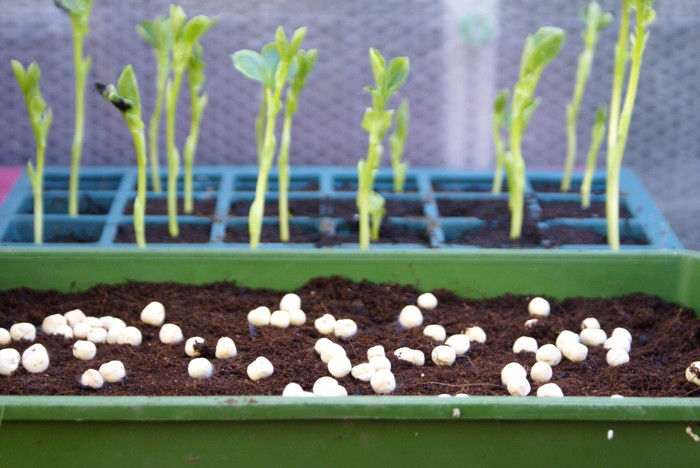In the deep midwinter…you can still sow broad beans and peas. The great thing about the greenhouse is that it provides an opportunity for the most out-of-season seed sowing. It isn’t actually out of season, it just severely feels it. I sowed my broad beans the day before midwinter’s day. The day had been dull, dreary and wet, and I sowed after dark, after dark being any time beyond about 4pm. It felt like the most lifeless, dormant moment of the year, a time when I didn’t even want to step outside, so couldn’t imagine anything wanting to live out there. All seeds should slowly rot off, or poke their heads up only to be smote down by frosts and hail. But if you choose the right ones they do neither. They grow.

I was sowing broad beans because I forgot to do it direct into the soil at the allotment in autumn. Usually I do, but this year it was one of those things that passed me by: a damp spell in autumn where it was easier to be lazy than to brave the soggy ground. Each year most of them come up, and it’s a joy to see them in autumn, when everything else is dead and brown and being cleared away. They look rudely healthy for a good few weeks, and then slowly start to look more and more battered over winter. By spring many are pretty decrepit, a few are left intact, and we get a small crop of precocious beans in early summer, but it’s not the most successful of strategies. I’m quite happy to be trying a different way. These will sit in the greenhouse all winter and hopefully go out at a time when the world will not treat them too harshly, to bring the early crop i love.
With the beans I have to admit that I lost my nerve slightly: I sowed them in a heated propagator indoors. The peas – on the other hand – are going into the greenhouse to try their luck. This is partly because they are a different story – not late but early – and so I feel no great rush to get them going. I am keen to have lots of small pea plants to plant out come spring though, as peas have always been my downfall, and this is something i am very keen to rectify this year. I’m sure I’m not the only one with early childhood memories of eating peas, sweet and juicy from the pod, and it’s an experience I’d love to pass on to my kids, were I not such a pea failure. If it’s not mice eating the seeds it’s slugs eating the seedlings, or – worse – pods full of maggots. My allotment next-door neighbour sows peas in great swathes, casually propped between two wires for support, and picks bucketsful of pods, and so I am trying to emulate him by broadcast sowing across a seed tray. My idea is to then plant out the entire tray of seedlings, keep them watered until they establish, and then send small children in among them to pick and eat with abandon, the slow realisation that vegetables are delicious slowly crossing their sweet, angelic faces, and good habits formed for life. No pressure, peas.
If you are sowing early you need to know the difference between smooth and wrinkled peas. Smooth seeded peas are much hardier and much less likely to rot off in the cold, wet, uncertain times of winter and early spring. They have the drawback that they turn starchy when the pods grow large, but this just means that they must be picked young and eaten soon after harvest, which is no great trial. The wrinkle-seeded types keep their natural sweetness for longer, but should only go in late in spring, when the soil has warmed. Real Seeds www.realseeds.co.uk sell many (clearly marked) smooth-seeded varieties, if you want to try some, and put the greenhouse to work in the service of future gardening memories this early in the year.


